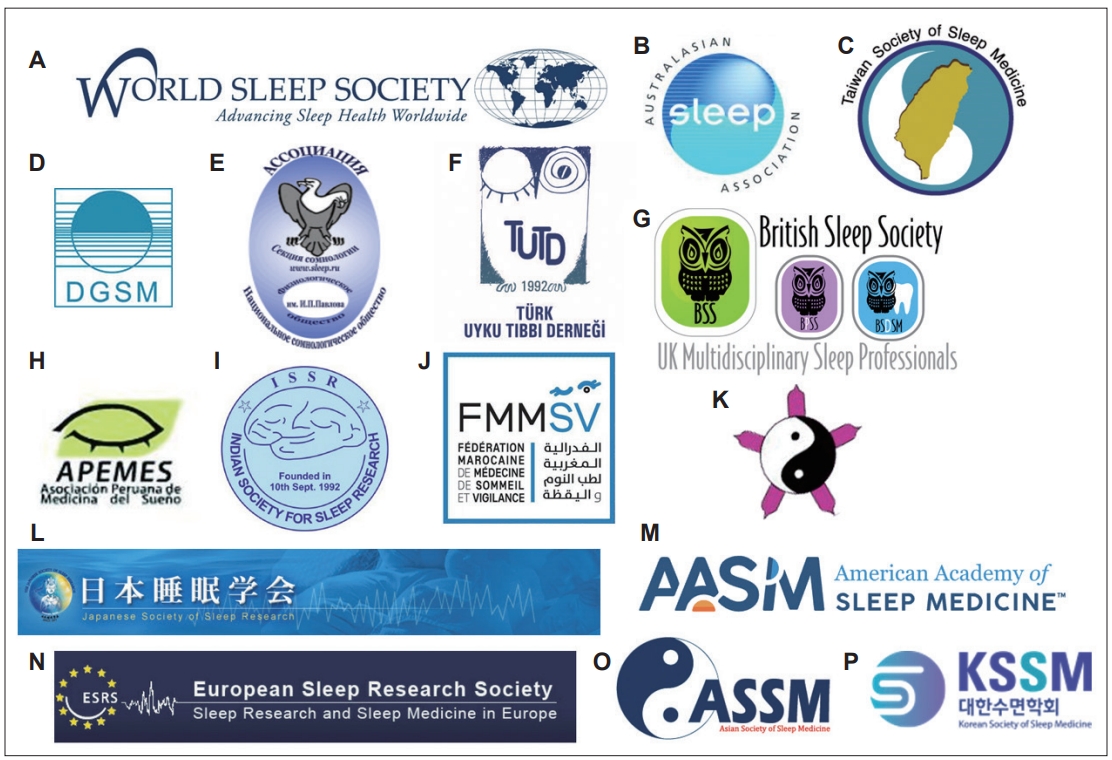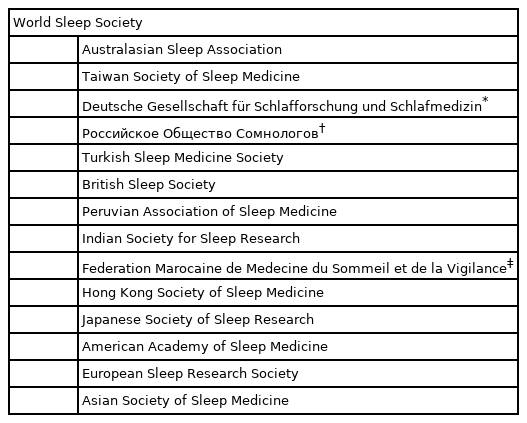Emblems of the Sleep Societies Around the World
Article information
Abstract
An emblem is a representative image and is different for each society. The images that symbolize sleep have similarities and differences between countries and cultures. This is an issue that everyone is familiar with but has never paid attention to. We obtained the information about the emblems from the website of each societies or personal communication with the executives around the world. The emblems of sleep societies represent the opposite concepts of night and day, designed to express its nationality, and several pictorial symbols related to sleep in their culture. Each society has its own identity and is devoted to sleep medicine. Intuitive concept of sleep is perceived differently in different cultures, and the sleep societies’ emblems contain their own identity as well as the concept of sleep. We believe this report may help promote the common interests of sleep medicine worldwide.
INTRODUCTION
An emblem is a picture with a motto or set of verses intended to represent a concept, group, idea, or person to represent a concept, group, idea, or person (e.g., saint, king) [1]. It is an abstract or representative image and implies the identity of the object. Well-crafted emblems naturally convey their meaning. Numerous organizations such as sports teams, companies, and countries have devised or adopted and used unique emblems with their own meanings and goals. Society (or association) refers to an organization related to scholarly activity such as academic research, lecture, education, social work, and academic journals. The establishment of sleep societies worldwide and interactions between them must have played a pivotal role in the improvement of sleep medicine in terms of academic and clinical aspects.
As a representative example of the sleep society, the World Sleep Society (WSS) was established in 2016 after the merger of the World Sleep Federation and the World Association of Sleep Medicine [2]. As of 2020, 43 sleep societies from different countries are members and have been organized and operated to develop sleep medicine and sleep research in each country [3].
People in different countries and cultures share similar concerns and goals. The societies evolved from a simple meeting to a virtual society and have adopted or used an emblem that contains their own theme and identity. Here we introduce the emblems of sleep-related societies around the world.
METHODS
We searched sleep societies based on the member societies of the WSS [3]. We obtained information about the emblems from the website of the societies. Additional information was collected by inquiring about the meaning of the emblem through the e-mail to the president, board members, or the office of the society. The emblems registered on the WSS website as of January 2021 were considered in this article.
RESULTS
There are 44 members societies in WSS, and we tried to investigate all of them. Except for those with insufficient information or no reply to the email, we were able to collect the information about 14 sleep societies (Table 1). In this study, 4 (28.6%) societies adopted Tai-chi and 3 (21.4%) exhibited nationality. 9 (64.3%) societies used English.
The WSS is currently the world’s most representative sleep society, and its goal is to advance knowledge of sleep, circadian rhythm, sleep health, and sleep disorders around the world [4]. The globe in the WSS’s emblem represents its global view (Fig. 1A) (personal communication with the WCC headquarters) and the phrase “ADVANCING SLEEP HEALTH WORLDWIDE” is the mission of WSS [5].

Emblems of the sleep societies around world. A: World Sleep Society. B: Australasian Sleep Association. C: Taiwan Society of Sleep Medicine. D: German Sleep Society. E: Russian Society of Somnologists. F: Turkish Sleep Medicine Society. G: British Sleep Society. H: Peruvian Association of Sleep Medicine. I: Indian Society for Sleep Research. J: Sleep and Wakefulness Medicine Moroccan Federation. K: Hong Kong Society of Sleep Medicine. L: Japanese Society of Sleep Research. M: American Academy of Sleep Medicine. N: European Sleep Research Society. O: Asian Society of Sleep Medicine. P: Korean Society of Sleep Medicine.
The emblem of the Australasian Sleep Association (Fig. 1B) represents sleep/wake with yin/yang symbol, also represents energy in/energy out, light/dark, active/passive. In addition, that the rotating clockwise (instead of anti-clockwise) refers to the reverse rotational force in the Southern hemisphere (personal communication with the membership manager).
In case of the Taiwan Society of Sleep Medicine (Fig. 1C) is transformed from a mark of Tai-chi (太極) with Yin (陰, nighttime, down, or moon) and Yan (陽, daytime, up, or sun) that represents the day and night. Furthermore, the central part is the map of Taiwan to represent the nation (personal communication with Dr. Ning-Hung Chen).
The emblem of the German Sleep Society (Deutsche Gesellschaft für Schlafforschung und Schlafmedizin in German, DGSM) appears to be quite straightforward (Fig. 1D). The emblem represents “sunset” (personal communication with DGSM headquarters).
In the emblem of the Russian Society of Somnologists, there is a two headed eagle with one head waking and the other sleeping (Fig. 1E). Three historical landmarks in the history of Russian sleep science are embedded in the emblem: 1) the importance of sleep for human life, described by a Russian sleep pioneer of the 19th century, Maria Manasseina; 2) the discovery of uni-hemispheric sleep in dolphins by Mukhametov et al. [6] in 1970s; 3) the discovery by Pigarev et al. [7] in 1990s of asynchronous development of sleep in cortical areas (personal communication with Dr. Vladimir M Kovalzon).
The emblem of the Turkish Sleep Medicine Society contains an owl, the animal of wisdom (Fig. 1F). The owl’s one eye is open, and the other is closed, and this represents “day & night” or “wake & sleep.” In addition, owls hunt at night and cannot see in the morning. In this sense, it represents a night worker including “sleep scientists” (personal communication with Dr. Hikmet Firat).
The British Sleep Society also adopted the owl, the animal of sleep and wisdom. There are several stories and myths about owl and sleep (e.g., the Roman goddess of wisdom Minerva has the owl as her sacred creature) (personal communication with Steier Joerg and Simon Durrant). Together with pediatrics and dentistry, they made an emblem of the color-coded coalition (Fig. 1G).
The emblem of the Peruvian Association of Sleep Medicine represents a closed eye that symbolizes the sleep state. The word “sueño” is a Spanish word meaning “sleep” (Fig. 1H) (personal communication with Darwin Vizcarra).
Fig. 1I shows the emblem of the Indian Society for Sleep Research. The emblem is a hand drawing of the sleeping brain designed by Dr. V Mohan Kumar, who said, “Sleep is a state of expression of the brain, by the brain and for the brain” (personal communication with Dr. H N Mallick).
The Sleep and Wakefulness Medicine Moroccan Federation (Federation Marocaine de Medecine du Sommeil et de la Vigilance in French, FMMSV) has an emblem that includes the society’s name in Arabic and French, the first and second languages in Morocco (Fig. 1J). This emblem has an eye open and a closed representing wakefulness and sleep (personal communication with Dr. Amal Satte).
The emblem of the Hong Kong Society of Sleep Medicine contains Tai-chi (Fig. 1K). The emblem designer included an idealized Bauhinia flower, which is the emblem of Hong Kong (personal communication with the designer of the emblem, Dr. Peter AuYeung).
There is a cultural asset (statue) in the emblem of the Japanese Society of Sleep Research (Fig. 1L). The office introduced us to the website of Hōryū temple (a UNESCO World Heritage Site), which had the statue of Yumechigai Kannon (personal communication). Yumechigai Kannon has been believed to transform nightmares into good dreams [8].
The emblem of the American Academy of Sleep Medicine (AASM) incorporates a few concepts. Laura Nesbitt, the original designer, explained that the AASM’s emblem stands for “When the sun sets, and the moon rises, this is where our journey begins” (personal communication). The sun is setting under the “A,” and the moon is rising on “M.” The “S” represents SLEEP between the sun setting and the moon rising. ‘Sans Serif’ represents boldness and long-lasting, and ‘Serif’ represents educational institute (Fig. 1M).
European Sleep Research Society is the founding member of WSS. The emblem is consisted of the symbol of the European Union (EU) (i.e., the stars), and short extract of an electroencephalography, and the name of the society (Fig. 1N) (personal communication with the business administrator Vroni Aumeier).
In order to get the information of the emblem of the Asian Society of Sleep Medicine (ASSM), we did touch base with Dr. Ning-Hung. He said, “In the emblem (Fig. 1O), the Tai-chi content a circle with the bright and dark area, up and down, sun and moon, that is Yin and Yan” (personal communication with Dr. Ning-Hung Chen).
Although Korean Society of Sleep Medicine (KSSM) is not an official member of the WSS, it has implications for emphasizing sleep. The abbreviation of the society was made into emblems, the capital S in a large circle and the green S in KSSM highlight SLEEP (Fig. 1P) [9].
DISCUSSION
The authors investigated the emblems of sleep societies around the world, and tried to figure out how sleep is perceived in the countries of different cultures. It appears that the sleep societies have tried to represent themselves using several pictorial symbols related to “the alternation of day and night” (e.g. closed eye, Tai-chi, owl), at times expressing native cultural elements (e.g. the stars of EU) and religious symbol (e.g., statue of Yumechigai Kannon).
Tai-chi, representing yin/yang is a classic concept of design used in Eastern world: The Australasian Sleep Association, Taiwan Society of Sleep Medicine, Hong Kong Society of Sleep Medicine, and ASSM. It is a dualistic pictorial image referring to two opposite forces that may also be complementary, even interdependent, and may give rise to each other. In order to exhibit the nationality, the examples of national emblem include the map of Taiwan, the double-headed eagle of Russia, and the stars forming a circle of EU. If there is Tai-chi in Eastern countries, there is owl in Western countries. Owl is the symbol of Turkish Sleep Medicine Society and British Sleep Society with the former’s owl one eye is closed representing sleep state. Closed eye is a typical pictorial symbol standing for sleep and was found in the emblems of Turkish Sleep Medicine Society, Peruvian Association of Sleep Medicine, Indian Society for Sleep Research, and FMMSV.
The emblem of AASM is the only one that contains not only the sun but also the MOON, and that of Hong Kong Society of Sleep Medicine is the only emblem that does not contain any letters. Only in Japan, a religious symbol was adopted in the emblem. The most common language used in the emblems was English, except for the sleep societies of Germany, Russia, Turkey, Peru, Morocco, and South Korea.
Sleep societies around the world have adopted distinctive emblems. Each society has its own identity and is devoted to sleep medicine. We hope that this report will emphasize the fact that despite variations, overall the symbolisms used by the sleep societies seem to have more in common than otherwise, and help promote the common interests of sleep medicine worldwide.
Notes
Availability of Data and Material
Data sharing not applicable to this article as no datasets were generated or analyzed during the study.
Authors’ Contributions
Conceptualization: Keun Tae Kim, Yong Won Cho. Data curation: all authors. Formal analysis: all authors. Investigation: Keun Tae Kim. Methodology: Keun Tae Kim. Project administration: Keun Tae Kim, Yong Won Cho. Supervision: Yong Won Cho. Visualization: all authors. Writing—original draft: Keun Tae Kim. Writing—review & editing: all authors.
Conflicts of Interest
The authors have no potential conflicts of interest to disclose.
Funding Statement
None

